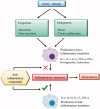Brazilian medicinal plants with corroborated anti-inflammatory activities: a review
- PMID: 29648503
- PMCID: PMC6130656
- DOI: 10.1080/13880209.2018.1454480
Brazilian medicinal plants with corroborated anti-inflammatory activities: a review
Abstract
Context: Inflammatory disorders are common in modern life, and medicinal plants provide an interesting source for new compounds bearing anti-inflammatory properties. In this regard, Brazilian medicinal plants are considered to be a promising supply of such compounds due to their great biodiversity.
Objectives: To undertake a review on Brazilian medicinal plants with corroborated anti-inflammatory activities by selecting data from the literature reporting the efficacy of plants used in folk medicine as anti-inflammatory, including the mechanisms of action of their extracts and isolated compounds.
Methods: A search in the literature was undertaken by using the following Web tools: Web of Science, SciFinder, Pub-Med and Science Direct. The terms 'anti-inflammatory' and 'Brazilian medicinal plants' were used as keywords in search engine. Tropicos and Reflora websites were used to verify the origin of the plants, and only the native plants of Brazil were included in this review. The publications reporting the use of well-accepted scientific protocols to corroborate the anti-inflammatory activities of Brazilian medicinal plants with anti-inflammatory potential were considered.
Results: We selected 70 Brazilian medicinal plants with anti-inflammatory activity. The plants were grouped according to their anti-inflammatory mechanisms of action. The main mechanisms involved inflammatory mediators, such as interleukins (ILs), nuclear factor kappa B (NF-κB), prostaglandin E2 (PGE2), cyclooxygenase (COX) and reactive oxygen species (ROS).
Conclusions: The collected data on Brazilian medicinal plants, in the form of crude extract and/or isolated compounds, showed significant anti-inflammatory activities involving different mechanisms of action, indicating Brazilian plants as an important source of anti-inflammatory compounds.
Keywords: COX; NF-κB; PGE2; ROS.
Figures
Similar articles
-
Anti-inflammatory and anti-oxidant effect of Calea urticifolia lyophilized aqueous extract on lipopolysaccharide-stimulated RAW 264.7 macrophages.J Ethnopharmacol. 2016 Jul 21;188:266-74. doi: 10.1016/j.jep.2016.04.057. Epub 2016 Apr 30. J Ethnopharmacol. 2016. PMID: 27139571
-
PDK1 in NF-κB signaling is a target of Xanthium strumarium methanolic extract-mediated anti-inflammatory activities.J Ethnopharmacol. 2016 Aug 22;190:251-60. doi: 10.1016/j.jep.2016.06.019. Epub 2016 Jun 7. J Ethnopharmacol. 2016. PMID: 27286918
-
Potential anti-inflammatory, antioxidant and antimicrobial activities of Sambucus australis.Pharm Biol. 2017 Dec;55(1):991-997. doi: 10.1080/13880209.2017.1285324. Pharm Biol. 2017. PMID: 28166708 Free PMC article.
-
Medicinal plants in Brazil: Pharmacological studies, drug discovery, challenges and perspectives.Pharmacol Res. 2016 Oct;112:4-29. doi: 10.1016/j.phrs.2016.01.021. Epub 2016 Jan 23. Pharmacol Res. 2016. PMID: 26812486 Review.
-
Evidence for the efficacy of anti-inflammatory plants used in Brazilian traditional medicine with ethnopharmacological relevance.J Ethnopharmacol. 2024 Jul 15;329:118137. doi: 10.1016/j.jep.2024.118137. Epub 2024 Apr 2. J Ethnopharmacol. 2024. PMID: 38574778 Review.
Cited by
-
Baccharis dracunculifolia DC Hydroalcoholic Extract Improves Intestinal and Hippocampal Inflammation and Decreases Behavioral Changes of Colitis Mice.Evid Based Complement Alternat Med. 2022 Mar 7;2022:5833840. doi: 10.1155/2022/5833840. eCollection 2022. Evid Based Complement Alternat Med. 2022. PMID: 35295931 Free PMC article.
-
Metabolites profiling of Mimusops caffra leaf via multiplex GC-MS and UPLC-MS/MS approaches in relation to its antioxidant and anti-inflammatory activities.Sci Rep. 2025 Apr 29;15(1):15072. doi: 10.1038/s41598-025-97161-6. Sci Rep. 2025. PMID: 40301498 Free PMC article.
-
Antinociceptive and anti-inflammatory activities of Ayapana triplinervis essential oil rich in thymohydroquinone dimethyl ether from Brazil.Inflammopharmacology. 2024 Oct;32(5):3375-3388. doi: 10.1007/s10787-024-01533-9. Epub 2024 Jul 22. Inflammopharmacology. 2024. PMID: 39039347
-
Caulerpa Cupressoides Var. Flabellata.Mar Drugs. 2019 Feb 9;17(2):105. doi: 10.3390/md17020105. Mar Drugs. 2019. PMID: 30744130 Free PMC article.
-
Investigating the potential of waste oyster shell as a sustainable bio-mordant in natural dyeing.Sci Rep. 2024 Oct 26;14(1):25509. doi: 10.1038/s41598-024-74944-x. Sci Rep. 2024. PMID: 39461980 Free PMC article.
References
-
- Adom MB, Taher M, Mutalabisin MF, Amri MS, Kudos MBA, Sulaiman MWAW, Sengupta P, Susantic D.. 2017. Chemical constituents and medical benefits of Plantago major. Biomed Pharmacother. 96:348–360. - PubMed
-
- Aherne SA, O’Brien NM.. 2002. Dietary flavonols: chemistry, food content, and metabolism. Nutrition (Burbank, Los Angeles County, CA). 18:75–81. - PubMed
-
- Ahn EK, Jeon HJ, Lim EJ, Jung HJ, Park EH.. 2007. Anti-inflammatory and anti-angiogenic activities of Gastrodia elata Blume. J Ethnopharmacol. 110:476–482. - PubMed
-
- Alexandre-Moreira MS, Piuvezam MR, Araújo CC, Thomas G.. 1999. Studies on the anti-inflammatory and analgesic activity of Curatella americana L. J Ethnopharmacol. 67:171–177. - PubMed
-
- Allen-Hall L, Arnasond JT, Cano P, Lafrenie RM.. 2010. Uncaria tomentosa acts as a potent TNF-alpha inhibitor through NF-kappaB. J Ethnopharmacol. 127:685–693. - PubMed
Publication types
MeSH terms
Substances
LinkOut - more resources
Full Text Sources
Other Literature Sources


